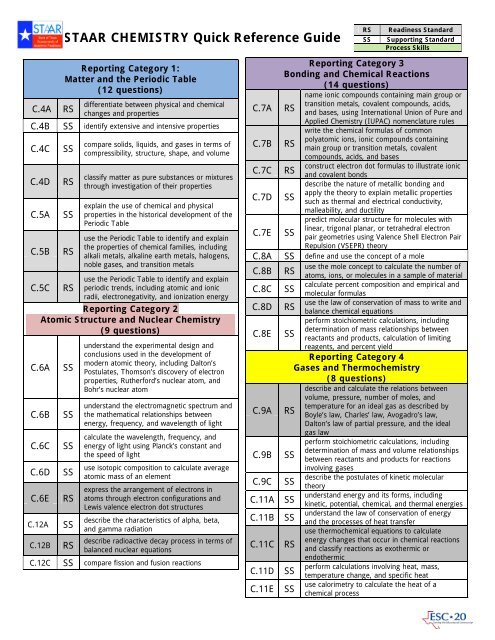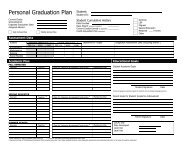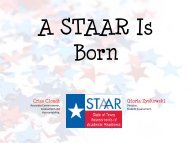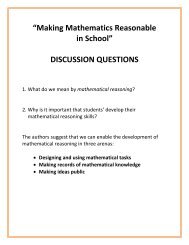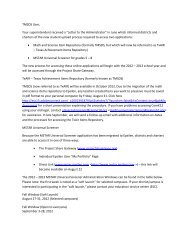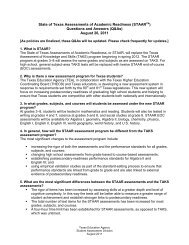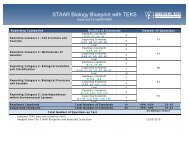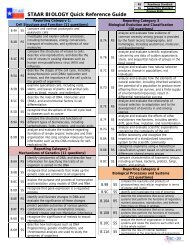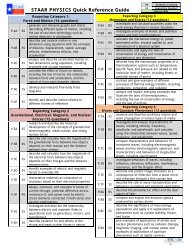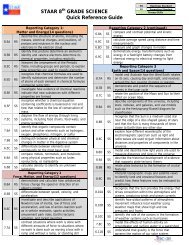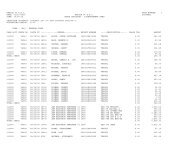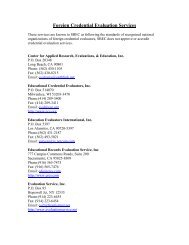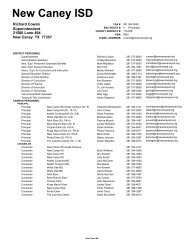STAAR CHEMISTRY Quick Reference Guide
STAAR CHEMISTRY Quick Reference Guide
STAAR CHEMISTRY Quick Reference Guide
Create successful ePaper yourself
Turn your PDF publications into a flip-book with our unique Google optimized e-Paper software.
C.4A RS<br />
<strong>STAAR</strong> <strong>CHEMISTRY</strong> <strong>Quick</strong> <strong>Reference</strong> <strong>Guide</strong><br />
Reporting Category 1:<br />
Matter and the Periodic Table<br />
(12 questions)<br />
differentiate between physical and chemical<br />
changes and properties<br />
C.4B SS identify extensive and intensive properties<br />
C.4C SS<br />
C.4D RS<br />
C.5A SS<br />
C.5B RS<br />
C.5C RS<br />
compare solids, liquids, and gases in terms of<br />
compressibility, structure, shape, and volume<br />
classify matter as pure substances or mixtures<br />
through investigation of their properties<br />
explain the use of chemical and physical<br />
properties in the historical development of the<br />
Periodic Table<br />
use the Periodic Table to identify and explain<br />
the properties of chemical families, including<br />
alkali metals, alkaline earth metals, halogens,<br />
noble gases, and transition metals<br />
use the Periodic Table to identify and explain<br />
periodic trends, including atomic and ionic<br />
radii, electronegativity, and ionization energy<br />
Reporting Category 2<br />
Atomic Structure and Nuclear Chemistry<br />
(9 questions)<br />
C.6A SS<br />
C.6B SS<br />
C.6C SS<br />
C.6D SS<br />
C.6E RS<br />
C.12A SS<br />
C.12B RS<br />
understand the experimental design and<br />
conclusions used in the development of<br />
modern atomic theory, including Dalton’s<br />
Postulates, Thomson’s discovery of electron<br />
properties, Rutherford’s nuclear atom, and<br />
Bohr’s nuclear atom<br />
understand the electromagnetic spectrum and<br />
the mathematical relationships between<br />
energy, frequency, and wavelength of light<br />
calculate the wavelength, frequency, and<br />
energy of light using Planck’s constant and<br />
the speed of light<br />
use isotopic composition to calculate average<br />
atomic mass of an element<br />
express the arrangement of electrons in<br />
atoms through electron configurations and<br />
Lewis valence electron dot structures<br />
describe the characteristics of alpha, beta,<br />
and gamma radiation<br />
describe radioactive decay process in terms of<br />
balanced nuclear equations<br />
C.12C SS compare fission and fusion reactions<br />
C.7A RS<br />
C.7B RS<br />
C.7C RS<br />
C.7D SS<br />
C.7E SS<br />
RS Readiness Standard<br />
SS Supporting Standard<br />
Process Skills<br />
Reporting Category 3<br />
Bonding and Chemical Reactions<br />
(14 questions)<br />
name ionic compounds containing main group or<br />
transition metals, covalent compounds, acids,<br />
and bases, using International Union of Pure and<br />
Applied Chemistry (IUPAC) nomenclature rules<br />
write the chemical formulas of common<br />
polyatomic ions, ionic compounds containing<br />
main group or transition metals, covalent<br />
compounds, acids, and bases<br />
construct electron dot formulas to illustrate ionic<br />
and covalent bonds<br />
describe the nature of metallic bonding and<br />
apply the theory to explain metallic properties<br />
such as thermal and electrical conductivity,<br />
malleability, and ductility<br />
predict molecular structure for molecules with<br />
linear, trigonal planar, or tetrahedral electron<br />
pair geometries using Valence Shell Electron Pair<br />
Repulsion (VSEPR) theory<br />
C.8A SS define and use the concept of a mole<br />
C.8B RS<br />
C.8C SS<br />
C.8D RS<br />
C.8E SS<br />
C.9A RS<br />
C.9B SS<br />
C.9C SS<br />
C.11A SS<br />
C.11B SS<br />
C.11C RS<br />
C.11D SS<br />
C.11E SS<br />
use the mole concept to calculate the number of<br />
atoms, ions, or molecules in a sample of material<br />
calculate percent composition and empirical and<br />
molecular formulas<br />
use the law of conservation of mass to write and<br />
balance chemical equations<br />
perform stoichiometric calculations, including<br />
determination of mass relationships between<br />
reactants and products, calculation of limiting<br />
reagents, and percent yield<br />
Reporting Category 4<br />
Gases and Thermochemistry<br />
(8 questions)<br />
describe and calculate the relations between<br />
volume, pressure, number of moles, and<br />
temperature for an ideal gas as described by<br />
Boyle’s law, Charles’ law, Avogadro’s law,<br />
Dalton’s law of partial pressure, and the ideal<br />
gas law<br />
perform stoichiometric calculations, including<br />
determination of mass and volume relationships<br />
between reactants and products for reactions<br />
involving gases<br />
describe the postulates of kinetic molecular<br />
theory<br />
understand energy and its forms, including<br />
kinetic, potential, chemical, and thermal energies<br />
understand the law of conservation of energy<br />
and the processes of heat transfer<br />
use thermochemical equations to calculate<br />
energy changes that occur in chemical reactions<br />
and classify reactions as exothermic or<br />
endothermic<br />
perform calculations involving heat, mass,<br />
temperature change, and specific heat<br />
use calorimetry to calculate the heat of a<br />
chemical process
Reporting Category 5<br />
Solutions<br />
(9 questions)<br />
C.10A SS<br />
C.10B RS<br />
C.10C SS<br />
C.10D SS<br />
C.10E RS<br />
C.10F RS<br />
C.10G SS<br />
C.10H RS<br />
C.10I SS<br />
C.10J SS<br />
Readiness<br />
Standards<br />
Supporting<br />
Standards<br />
describe the unique role of water in<br />
chemical and biological systems<br />
develop and use general rules<br />
regarding solubility through<br />
investigations with aqueous solutions<br />
calculate the concentration of solutions<br />
in units of molarity<br />
use molarity to calculate the dilutions<br />
of solutions<br />
distinguish between types of solutions<br />
such as electrolytes and<br />
nonelectrolytes and unsaturated,<br />
saturated, and supersaturated<br />
solutions<br />
investigate factors that influence<br />
solubilities and rates of dissolution<br />
such as temperature, agitation, and<br />
surface area<br />
define acids and bases and distinguish<br />
between Arrhenius and Bronsted-<br />
Lowry definitions and predict products<br />
in acid-base reactions that form water<br />
understand and differentiate among<br />
acid-base reactions, precipitation<br />
reactions, and oxidation-reduction<br />
reactions<br />
define pH and use the hydrogen or<br />
hydroxide ion concentrations to<br />
calculate the pH of a solution<br />
distinguish between degrees of<br />
dissociation for strong and weak acids<br />
and bases<br />
Number of<br />
Standards<br />
Number of Questions<br />
17 60 – 65% 31 – 34<br />
26 35 – 40% 18 – 21<br />
47 Multiple Choice and 5 Griddable<br />
C.1A<br />
C.1B<br />
C.1C<br />
C.2A<br />
C.2B<br />
C.2C<br />
C.2D<br />
C.2E<br />
C.2F<br />
C.2G<br />
C.2H<br />
C.2I<br />
C.3A<br />
C.3B<br />
C.3C<br />
C.3D<br />
C.3E<br />
C.3F<br />
Process Skills<br />
Embedded in at least 40% of the questions<br />
demonstrate safe practices during laboratory and field<br />
investigations, including the appropriate use of safety<br />
showers, eyewash fountains, safety goggles, and fire<br />
extinguishers<br />
know specific hazards of chemical substances such as<br />
flammability, corrosiveness, and radioactivity as<br />
summarized on the Material Safety Data Sheets (MSDS)<br />
demonstrate an understanding of the use and<br />
conservation of resources and the proper disposal or<br />
recycling of materials<br />
know the definition of science and understand that it has<br />
limitations, as specified in subsection (b)(2) of this section<br />
know that scientific hypotheses are tentative and testable<br />
statements that must be capable of being supported or<br />
not supported by observational evidence. Hypotheses of<br />
durable explanatory power which have been tested over a<br />
wide variety of conditions are incorporated into theories<br />
know that scientific theories are based on natural and<br />
physical phenomena and are capable of being tested by<br />
multiple independent researchers. Unlike hypotheses,<br />
scientific theories are well-established and highly-reliable<br />
explanations, but may be subject to change as new areas<br />
of science and new technologies are developed<br />
distinguish between scientific hypotheses and scientific<br />
theories<br />
plan and implement investigative procedures, including<br />
asking questions, formulating testable hypotheses, and<br />
selecting equipment and technology, including graphing<br />
calculators, computers and probes, sufficient scientific<br />
glassware such as beakers, Erlenmeyer flasks, pipettes,<br />
graduated cylinders, volumetric flasks, safety goggles,<br />
and burettes, electronic balances, and an adequate supply<br />
of consumable chemicals<br />
collect data and make measurements with accuracy and<br />
precision<br />
express and manipulate chemical quantities using<br />
scientific conventions and mathematical procedures,<br />
including dimensional analysis, scientific notation, and<br />
significant figures<br />
organize, analyze, evaluate, make inferences, and predict<br />
trends from data<br />
communicate valid conclusions supported by the data<br />
through methods such as lab reports, labeled drawings,<br />
graphs, journals, summaries, oral reports, and<br />
technology-based reports<br />
in all fields of science, analyze, evaluate, and critique<br />
scientific explanations by using empirical evidence, logical<br />
reasoning, and experimental and observational testing,<br />
including examining all sides of scientific evidence of<br />
those scientific explanations, so as to encourage critical<br />
thinking by the student<br />
communicate and apply scientific information extracted<br />
from various sources such as current events, news<br />
reports, published journal articles, and marketing<br />
materials<br />
draw inferences based on data related to promotional<br />
materials for products and services<br />
evaluate the impact of research on scientific thought,<br />
society, and the environment<br />
describe the connection between chemistry and future<br />
careers<br />
research and describe the history of chemistry and<br />
contributions of scientists


